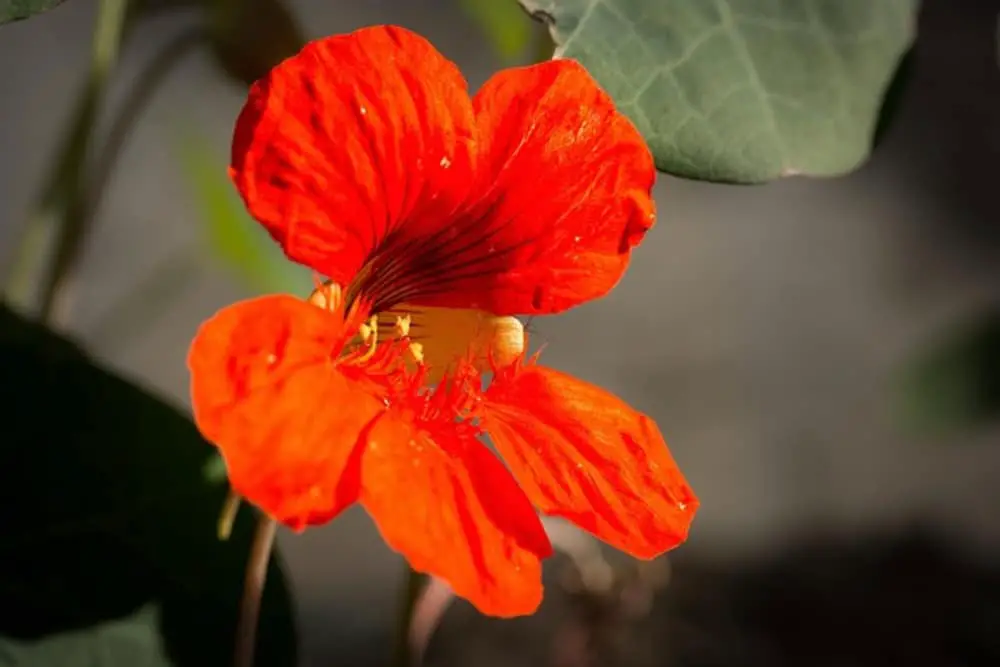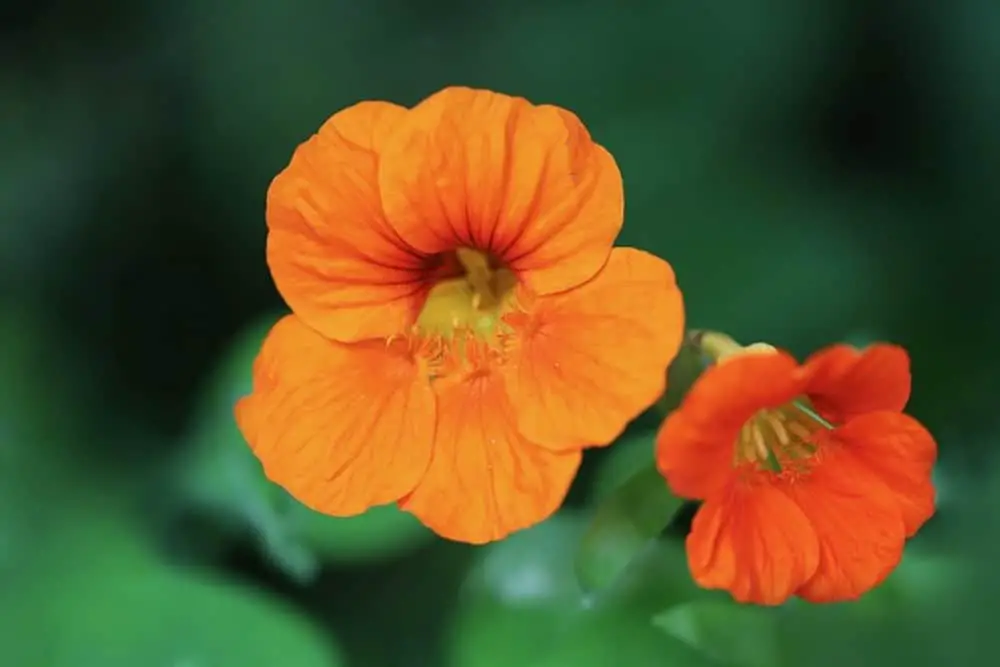The nasturtiums are charming dainty flowers that will surely get you intrigued with its warm colors. The name itself is already an interesting catch! The flowers are mostly simple and not as out of the ordinary as the rest of the flora out there, but the meaning and symbolism behind these will definitely make them stand out in a floral crowd!
It is commonly and popularly used in the ornamental and culinary fields as well as in folklore medicine. It’s a great choice to add into your home garden. There are various meanings behind each color of the nasturtium.
For example, a white nasturtium symbolizes purity. A red nasturtium symbolizes a passionate love. Meanwhile, a yellow or an orange nasturtium represents new beginnings or celebrating achievements. Keep on reading and it is a sure bet that you will add the nasturtiums to your garden collection!
History of the Nasturtium Flowers
The plant nasturtiums were first defined in 1704 as an annual herbaceous plant with a trailing habit of growth. Nasturtium plants have showy spurred flowers with edible, shield shaped leaves and seeds.
The flowers are native to Central and South American countries. It was found growing in most damp areas in Mexico and Peru and was used as a food substitute for watercress! If you don’t know what watercress is, it is a staple vegetable in the diet of many brave Roman warriors!
The Nasturtiums belong to the genus Tropaeolum of the Tropaeolaceae family. Sometimes, the same floral name Nasturtium arises from the Brassicaceae or crucifer family. It is more often than not, mistaken to be identical with the garden cress!
Tropaeolum also has some interesting facts. It comes from the Greek word tropaion meaning trophy. The genus got its name from the v-shaped figure of the flower appearing like a combat helmet! The story behind this intriguing past will be revealed if you keep reading!
This genus originally comes from a Greek word meaning to twine. In Latin, this common name can come from several words. Those Latin words include nast meaning nose and torquere meaning a nose twister or nose tweaker – pertaining to the plant’s nose-twist-like habit of growth. Its shape is sometimes also referred to as a convulsed nose.
Did you know that Nasturtiums have a nickname? For one thing, some folks call these the Nasties! A few of the crowd-favorite Nasties include the common Nasturtium (T. minor), the Indian cress (T. majus), the Shield Nasturtium (T. peltophorum), and the Canary creeper (T. peregrinum). These flowers love direct sunlight and full sun growing conditions.
Symbolism of the Nasturtium Flowers
The symbolism of nasturtium flowers in the Victorian language of flowers dates back a few hundred years. In the 16th century, the nasturtiums were first brought to Europe from an expedition in Mexico.
For many Europeans during Victorian times, a nasturtium flower symbolize successful conquest and victory in battle. This is the reason why its genus name of the nasturtium represents a trophy! The flowers are actual trophies for the Europeans from battle!
It is truly a great addition to have in your garden.

Meaning of the Nasturtium Flowers
The deep flower meaning behind the Nasties arises from the long history of the Victorian language of flowers. After the many battles Europe faced, it only seemed fit that they returned with a trophy – and in this case, it was the Nasties.
There are other different meanings behind the nasturtiums. The Nasties have a symbolic meaning of power and victory. Just as vast and powerful as the European nation is, this flower’s simplicity and beauty are perfect for a prize!
On another note, nasturtium comes with another brave meaning. A nasturtium means patriotism and unwavering support for the home country’s conquest!
What does a White Nasturtium Flower Represent?
White nasturtiums have a very special meaning. These white flowers represent purity and innocence.
What does a Red Nasturtium Flower Mean?
A maternal love is what bright red nasturtiums mean. Maternal love can either mean the love of a mother or a love for your motherland! Showing this kind of love can indicate the attribute of being reliable – like any kind of love, can always count on it!
Additionally, red nasturtiums also symbolize a strong desire towards a deep passion.
What does a Yellow Nasturtium Flower Symbolize?
Yellow nasturtiums symbolize a hopeless kind of love. You would think that all kinds of love are full of hope and a happy ending – but this yellow nasturtium doesn’t mean that. During moments of feeling low, these yellow flowers are a great tribute to symbolize resignation and knowing when to give up. But don’t fret – you can always try again next time! Never lose hope!
What is an Orange Nasturtium Flower Meaning?
An orange nasturtium flower indicates the attributes of being charitable. Additionally, these flowers indicate a wondrous adventure and a life full of risk-taking and seeking new activities to enjoy! Just like the expedition that brought the orange nasturtiums to Europe, being a life adventurer is not far from what it truly symbolizes.

What is the Cultural Significance of a Nasturtium Flower?
In the Chinese art of Feng Shui, the nasturtiums are believed to be harmonious flowers. According to the arts, the flowers have mystic powers that can harmonize the energies between buildings and the foundation of land it sits on. It brings balance and peace to the environment.
During the unfortunate events of World War II, the nasturtiums played a very important role as a food staple. Popularly associated as the greens of Trojan warriors, the Nasties served as a spice substitute for black pepper during this time!
Today, nasturtiums are found to be growing abundantly in the French Royal Gardens.
What are the Folktales Associated with a Nasturtium Flower?
The intriguing folktales about the nasturtiums differ from one belief to another. In some cultures, the Latin genus name was said to have a dark past. The red nasturtiums that came to be were from the blood of a dying Trojan warrior!
Meanwhile, the Victorians have a rather different tale to tell about this flower. Victorian women were said to have used the nasturtiums as their tussie mussies. What is a tussie mussie? It’s a kind of bouquet arranged in concentric circles! Adorning Nasties on tussie mussies were believed to ward off foul smells!
What is the Spiritual Influence of a Nasturtium Flower?
The floral essence of nasturtiums offers numerous rays of spiritual influence. Having mental blocks or zoning out? These flowers assist in clearing mental blocks caused by grief and stress. In some cases where clearing such blocks does not work, the flowers initiate change by giving the strength and courage needed in the process.
In general, the presence of these blossoms reminds one to cherish their independence and uniqueness. These flowers are the embodiment and reminder of expression and freedom. Additionally, these flowers also bring with them positive energy while repelling negative energy that approaches.
What does a Nasturtium Flower Tattoo Symbolize?
In the most common sense, you already know what a tattoo of this design symbolizes. It obviously symbolizes conquest and victory! Victory does not always have to be in the form of a battle against another. This kind of victory can also symbolize self-improvement and progress – being better than the last version of yourself!
Uses of Nasturtiums
Nasturtiums are a fun favorite as an ornamental flowering plant because of its special feature. Aside from being an ornamental plant with a sweet smelling scent, it is popularly used in floral arrangements.
It’s a valuable addition to have nasturtiums in your garden as it can repel pests and can attract beneficial insects.
Many plant lovers grow these blooms in their edible gardens! You read that right, edible! The blossoms are popularly used as a fresh garnish in salads and dishes. The nasturtium leaves are also used as greens in fresh salads and other many dishes worldwide! It is enriched with vitamin C and adds a similar taste or a peppery taste when garnished in salads.
The flower buds are also edible like the blossoms and leaves. It is popularly picked and used as a substitute for capers! In the Andes mountain ranges of South America, the Mashua (T. tuberosum) is also popularly used as a food substitute for potatoes!
There are also several folkloric medical uses and medicinal properties for the nasturtiums. For the Indians in Peru, the leaves were used for treating common ailments and strengthen the immune system. Since the leaves contain high amounts of vitamin C, it acts as a natural antibiotic and is commonly used as a poultice for cuts and wounds.
A word of warning that it’s a must to always consult a medical professional before using this plant or any part of it for medical purposes.
~ image source: depositphotos/photollurg2

